
The rose subfamily Rosoideae consists of more than 850 species, including many shrubs, perennial herbs, and fruit plants such as strawberries and brambles. Only a few are annual herbs.

Aralia, or spikenard, is a genus of the family Araliaceae, consisting of 68 accepted species of deciduous or evergreen trees, shrubs, and rhizomatous herbaceous perennials. The genus is native to Asia and the Americas, with most species occurring in mountain woodlands. Aralia plants vary in size, with some herbaceous species only reaching 50 centimetres (20 in) tall, while some are trees growing to 20 metres (66 ft) tall.
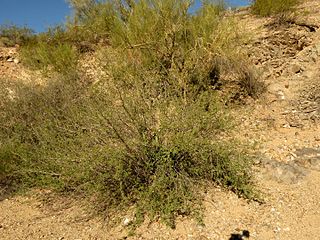
Coursetia is a genus of flowering plants in the pea family, Fabaceae. Members of the genus, commonly known as babybonnets, are shrubs and small trees native to the Southwestern United States, Mexico, the Caribbean, Central America, and South America as far south as Brazil and Peru. The genus is named for French botanist Georges Louis Marie Dumont de Courset (1746–1824).

Cochemiea is a genus of cactus. It has previously been synonymized with Mammillaria, but molecular phylogenetic studies have shown that when broadly circumscribed, Mammillaria is not monophyletic, and Cochemiea has been accepted as a separate genus.
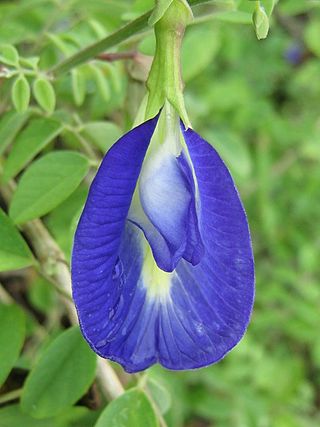
Clitoria is a genus of mainly tropical and subtropical, insect-pollinated flowering pea vines.

Cynometra is genus of tropical forest trees with a pantropical distribution.

Brongniartia is a genus of leguminous plants in family Fabaceae. It includes 63 species native to Mexico and Texas and to Bolivia. The genus was first named by Kunth after the French botanist Adolphe Brongniart.
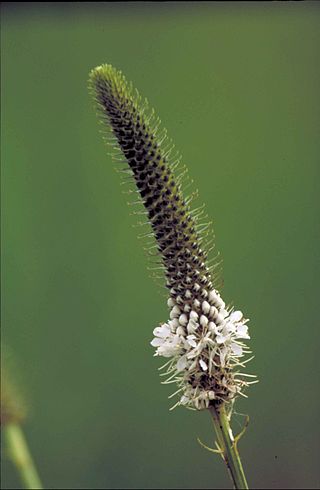
Dalea is a genus of flowering plants in the legume family, Fabaceae. Members of the genus are commonly known as prairie clover or indigo bush. Its name honors English apothecary Samuel Dale (1659–1739). They are native to the Western hemisphere, where they are distributed from Canada to Argentina. Nearly half of the known species are endemic to Mexico. Two species of Dalea have been considered for rangeland restoration.

Tephrosia is a genus of flowering plants in the family Fabaceae. It is widespread in both the Eastern and Western Hemisphere, where it is found in tropical and warm-temperate regions.

Aeschynomene is a genus of flowering plants in the family Fabaceae, and was recently assigned to the informal monophyletic Dalbergia clade of the Dalbergieae. They are known commonly as jointvetches. They range across tropical and subtropical regions of the Americas, sub-Saharan Africa, south, southeast, and east Asia, and Australia. These legumes are most common in warm regions and many species are aquatic.
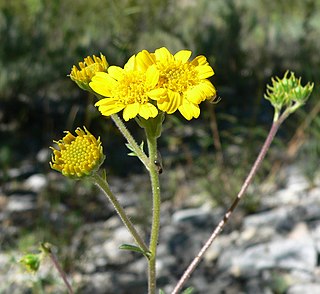
Hymenothrix is a small genus of North American flowering plants in the daisy family known as thimbleheads. They are native to the southwestern United States and northern Mexico.
Setchellanthus caeruleus is a species of pungent shrub with large blue flowers. It is placed alone in the genus Setchellanthus, which is in turn, is placed alone in the family Setchellanthaceae. It is endemic to Mexico.
Nissolia, the yellowhoods, is a genus of lianas in the legume family, Fabaceae. It includes 32 species native to the tropical and subtropical Americas, ranging from Arizona and Texas through Mexico, Central America, and South America to northern Argentina. It belongs to the subfamily Faboideae, and was recently assigned to the informal monophyletic Adesmia clade of the Dalbergieae.

The tribe Millettieae is one of the subdivisions of the plant family Fabaceae.

Mary Katharine "Kate" Brandegee was an American botanist known for her comprehensive studies of flora in California.

Rhinotropis is a small genus in the family Polygalaceae. It was separated as a genus from Polygala by J. Richard Abbott in 2011. It is native to the south and west of the United States and to Mexico.
Pinarophyllon is a genus of flowering plants belonging to the family Rubiaceae.

Gambelia is a genus of flowering plants in the Antirrhineae tribe of the plantain family commonly known as bush snapdragons. This genus is native to northwestern Mexico, particularly the Baja California Peninsula, but species are also found on the coast of Sonora, Guadalupe Island, and the Channel Islands of California. The genus is named in honor of William Gambel (1823–1849), an American naturalist, ornithologist, and botanist.
Hesperothamnus brachycalyx is a species of flowering plants in the family Fabaceae. It is a low shrub with the bark of the stem dark - gray and young branches finely velutinous. It is native to southwest Mexico.
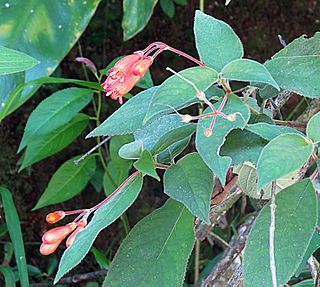
Moussonia is a genus of plants in the family Gesneriaceae. Its native range stretches from Mexico to Central America. It is found in Costa Rica, El Salvador, Guatemala, Honduras, Mexico and Panamá.















